1993 CADILLAC FLEETWOOD change time
[x] Cancel search: change timePage 189 of 386

Downloaded from www.Manualslib.com manuals search engine r As you brake, your computer keeps receiving updates on wheel speed and
controls braking pressure accordingly.
r
A CAUTION:
Anti-lock doesn’t change the time you need to get your foot up to
the brake pedal.
If you get too close to the vehicle in front of
you, you won’t have time to apply your brakes if that vehicle
suddenly slows
or stops. Always leave enough room up ahead to
stop, even though you have anti-lock brakes.
To Use Anti-Lock:
Don’t pump the brakes. Just hold the brake pedal down and let anti-lock
feel the brake pedal pulsate, but this is normal.
-- work for you. You may hear the anti-lock pump or motor operate, and
175
Page 193 of 386
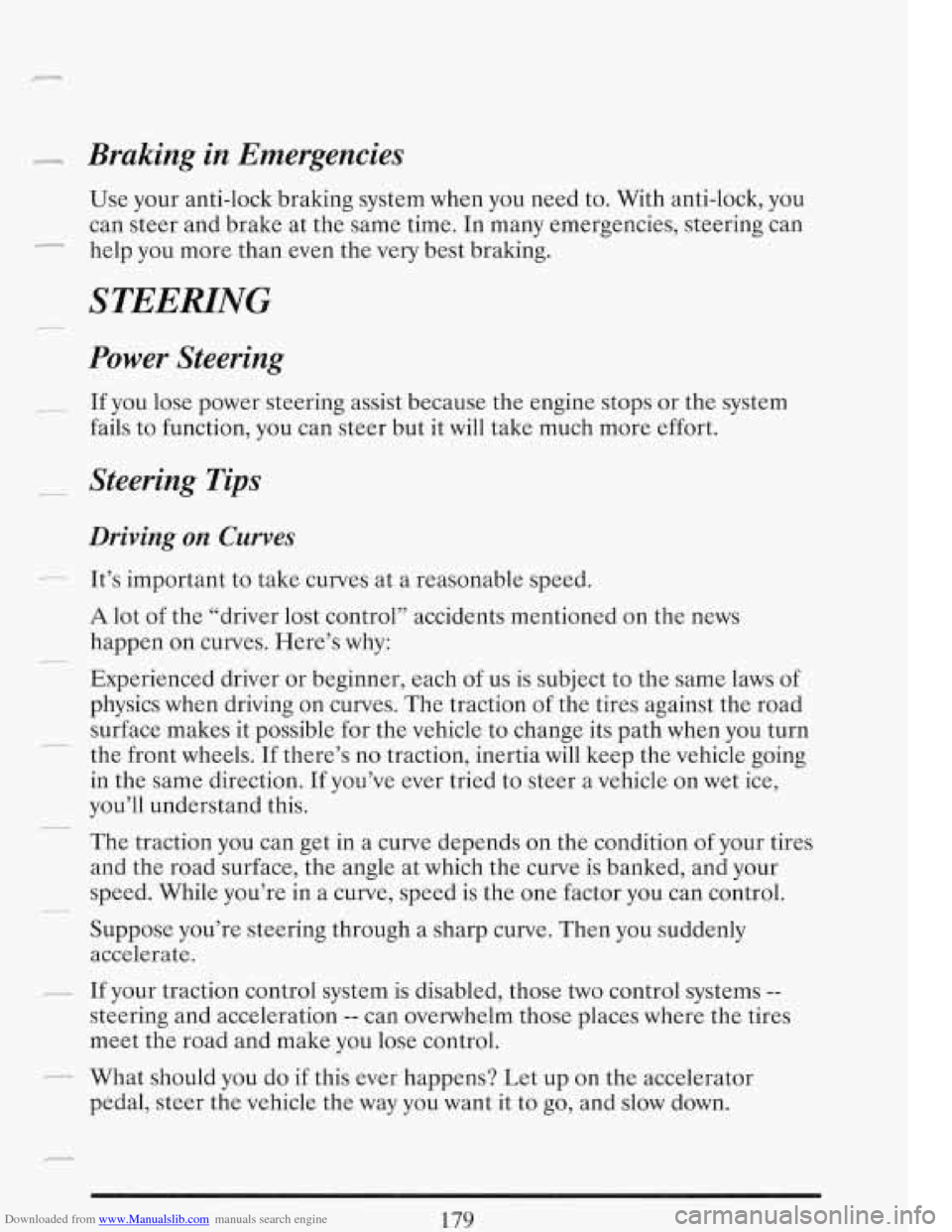
Downloaded from www.Manualslib.com manuals search engine Braking in Emergencies
Use your anti-lock braking system when you need to. With anti-lock, you
can steer and brake at the same time. In many emergencies, steering can
help you more than even the very best braking.
STEERING
Power Steering
If you lose power steering assist because the engine stops or the system
fails to function, you can steer but it will take much more effort.
Steering Tips
Driving on Curves
It’s important to take curves at a reasonable speed.
A lot of the “driver lost control” accidents mentioned on the news
happen on curves. Here’s why:
Experienced driver
or beginner, each of us is subject to the same laws of
physics when driving on curves. The traction
of the tires against the road
surface makes it possible for the vehicle to change its path when you turn
the front wheels. If there’s no traction, inertia
will keep the vehicle going
in the same direction. If you’ve ever tried to steer
a vehicle on wet ice,
you’ll understand this.
The traction you can get in a curve depends on the condition
of your tires
and the road surface, the angle at which the curve is banked, and your
speed. While you’re in a curve, speed is the
one factor you can control.
Suppose you’re steering through a sharp curve. Then you suddenly
accelerate.
If your traction control system
is disabled, those two control systems --
steering and acceleration -- can overwhelm those places where the tires
meet the road and make you lose control.
What should you do if this ever happens? Let up on the accelerator
pedal, steer the vehicle the way you want it to go, and slow down.
179
Page 197 of 386
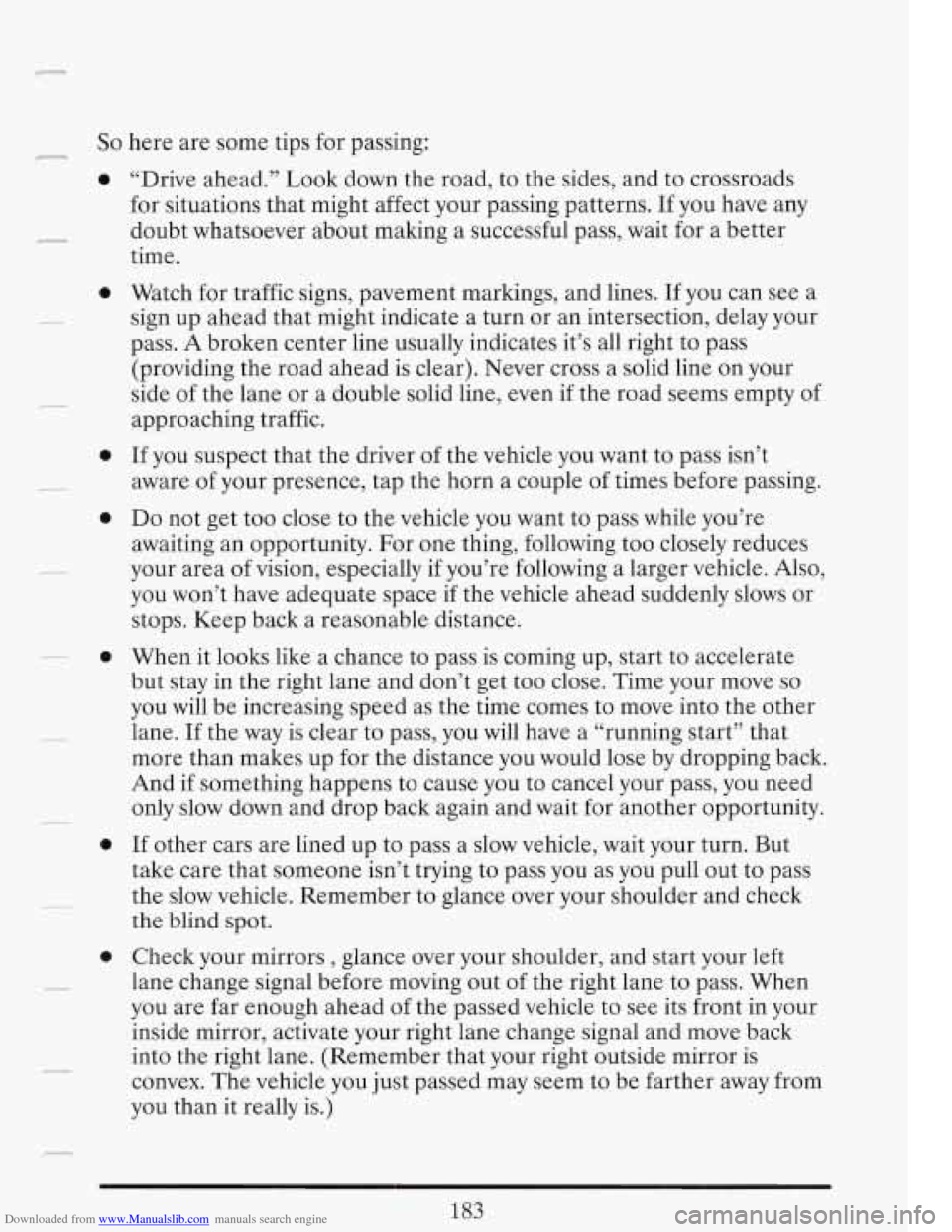
Downloaded from www.Manualslib.com manuals search engine So here are some tips for passing:
0
r
0
0
0
._ 0
0
0
“Drive ahead.” Look down the road, to the sides, and to crossroads
for situations that might affect your passing patterns.
If you have any
doubt whatsoever about making a successful pass, wait for
a better
time.
Watch for traffic signs, pavement markings, and lines. If you can see a
sign up ahead that might indicate a turn or an intersection, delay your
pass.
A broken center line usually indicates it’s all right to pass
(providing the road ahead is clear). Never cross a solid line on your
side
of the lane or a double solid line, even if the road seems empty of
approaching traffic.
If you suspect that the driver of the vehicle you want to pass isn’t
aware
of your presence, tap the horn a couple of times before passing.
Do not get too close to the vehicle you want to pass while you’re
awaiting an opportunity. For one thing, following too closely reduces
your area of vision, especially if you’re following a larger vehicle.
Also,
you won’t have adequate space if the vehicle ahead suddenly slows or
stops. Keep back a reasonable distance.
When it looks like a chance to pass is coming up, start to accelerate
but stay in the right lane and don’t get
too close. Time your move so
you will be increasing speed as the time comes to move into the other
lane. If the way is clear to pass, you will have a “running start” that
more than makes up for the distance you would lose by dropping back.
And if something happens
to cause you to cancel your pass, you need
only slow down and drop back again and wait for another opportunity.
If other cars are lined up to pass a slow vehicle, wait your turn. But
take care that someone isn’t trying to pass you as you pull out to pass
the slow vehicle. Remember to glance over your shoulder and check
the blind spot.
Check your mirrors
, glance over your shoulder, and start your left
lane change signal before moving out of the right lane to pass. When
you are far enough ahead of the passed vehicle to see its front in your
inside mirror, activate your right lane change signal and move back
into the right lane. (Remember that your right outside mirror is
convex. The vehicle you just passed may seem to be farther away from
you than it really is.)
Page 199 of 386
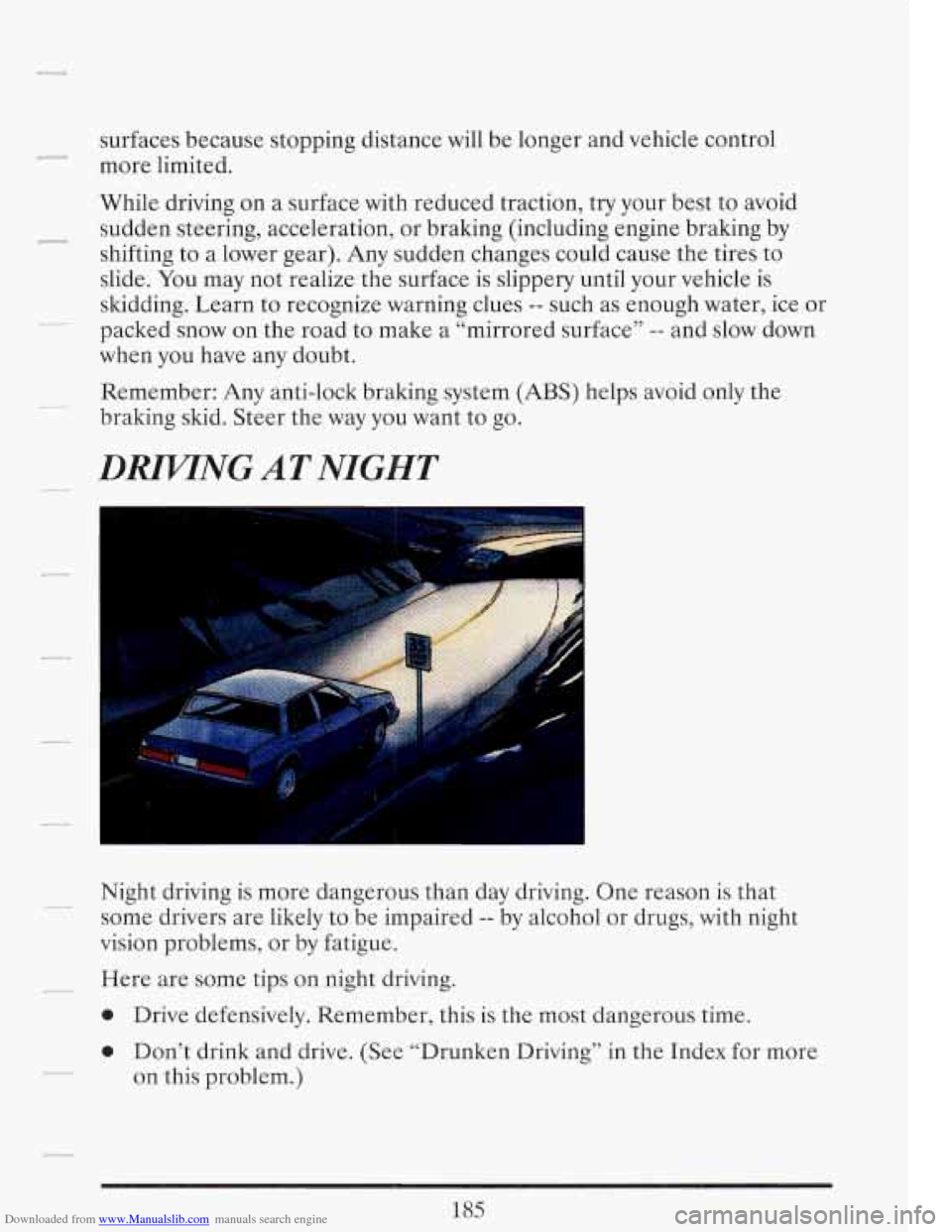
Downloaded from www.Manualslib.com manuals search engine surfaces because stopping distance will be longer and vehicle control
more limited.
While driving on a surface with reduced traction, try your best to avoid
sudden steering, acceleration, or braking (including engine braking by
shifting to a lower gear). Any sudden changes could cause the tires to
slide.
You may not realize the surface is slippery until your vehicle is
skidding. Learn to recognize warning clues
-- such as enough water, ice or
packed snow on the road to make a “mirrored surface”
-- and slow down
when you have any doubt.
Remember: Any anti-lock braking system
(ABS) helps avoid only the
braking skid. Steer the way you want to go.
DRMNG AT NIGHT
Night driving is more dangerous than day driving. One reason is that
some drivers are likely to be impaired
-- by alcohol or drugs, with night
vision problems, or by fatigue. --
I_ Here are some tips on night driving.
0 Drive defensively. Remember, this is the most dangerous time.
0 Don’t drink and drive. (See “Drunken Driving” in the Index for more
on this problem.)
Page 211 of 386
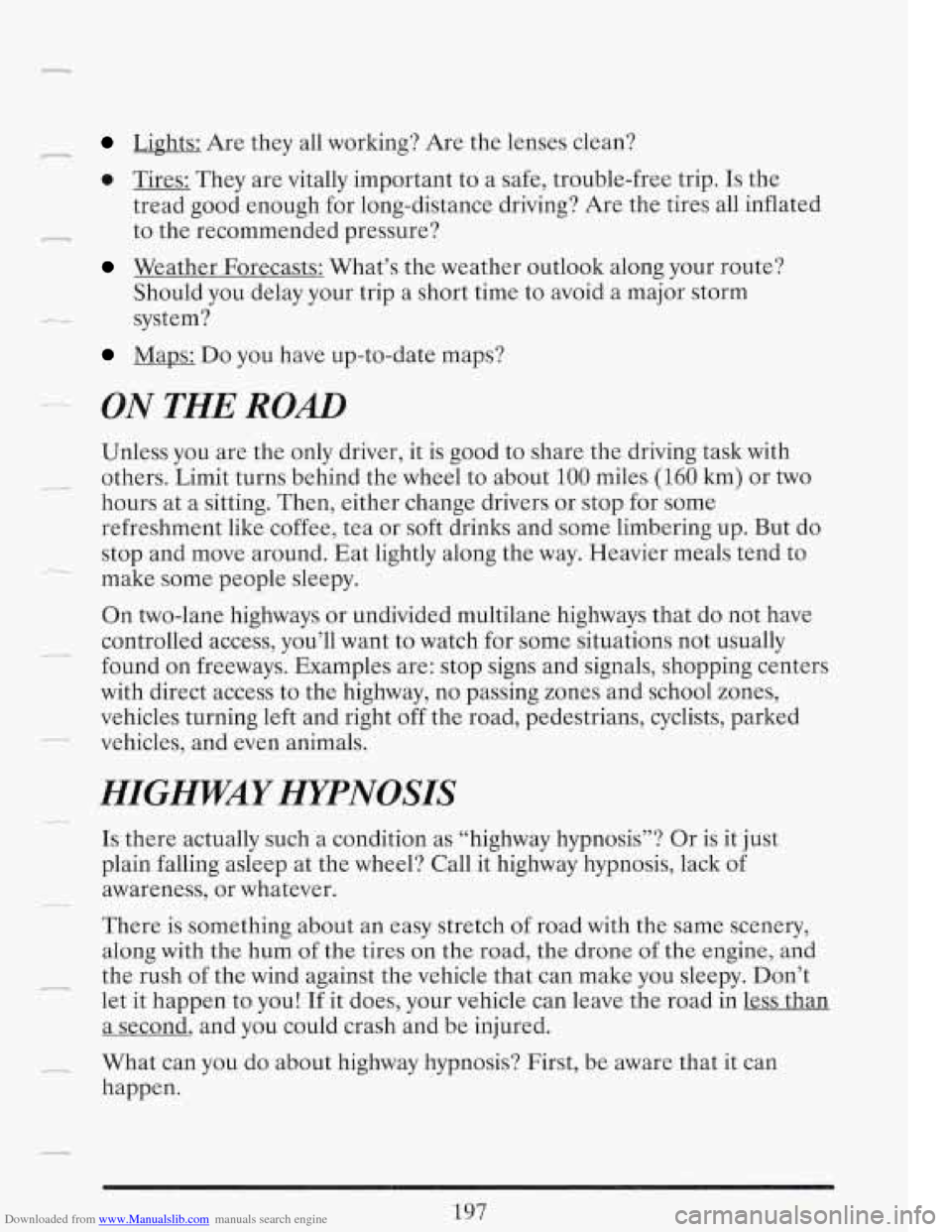
Downloaded from www.Manualslib.com manuals search engine - Lights: Are they all working? Are the lenses clean?
0 Tires: They are vitally important to a safe, trouble-free trip. Is the
tread good enough for long-distance driving? Are the tires all inflated
to the recommended pressure?
Weather Forecasts: What’s the weather outlook along your route?
Should you delay your trip a short time to avoid a major storm
system?
Maps: Do you have up-to-date maps?
_- - ON THE ROAD
Unless you are the only driver, it is good to share the driving task with
hours at a sitting. Then, either change drivers or stop for some
refreshment like coffee, tea or soft drinks and some limbering up. But do
stop and move around. Eat lightly along the way. Heavier meals tend
to
make some people sleepy.
- others. Limit turns behind the wheel to about 100 miles (160 km) or two
- ._
On two-lane highways or undivided multilane highways that do not have
controlled access, you’ll want to watch for some situations not usually
found on freeways. Examples are: stop signs and signals, shopping centers
with direct access to the highway,
no passing zones and school zones,
vehicles turning left and right off the road, pedestrians, cyclists, parked
vehicles, and even animals.
-
-
HIGWAY HYPNOSIS
c_
Is there actually such a condition as “highway hypnosis”? Or is it just
plain falling asleep at the wheel? Call it highway hypnosis, lack
of
awareness, or whatever.
There is something about an easy stretch of road with the same scenery,
along with the hum
of the tires on the road, the drone of the engine, and
- the rush of the wind against the vehicle that can make you sleepy. Don’t
let it happen
to you! If it does, your vehicle can leave the road in less than
a second, and you could crash and be injured.
happen.
__
- What can you do about highway hypnosis? First, be aware that it can
Page 222 of 386
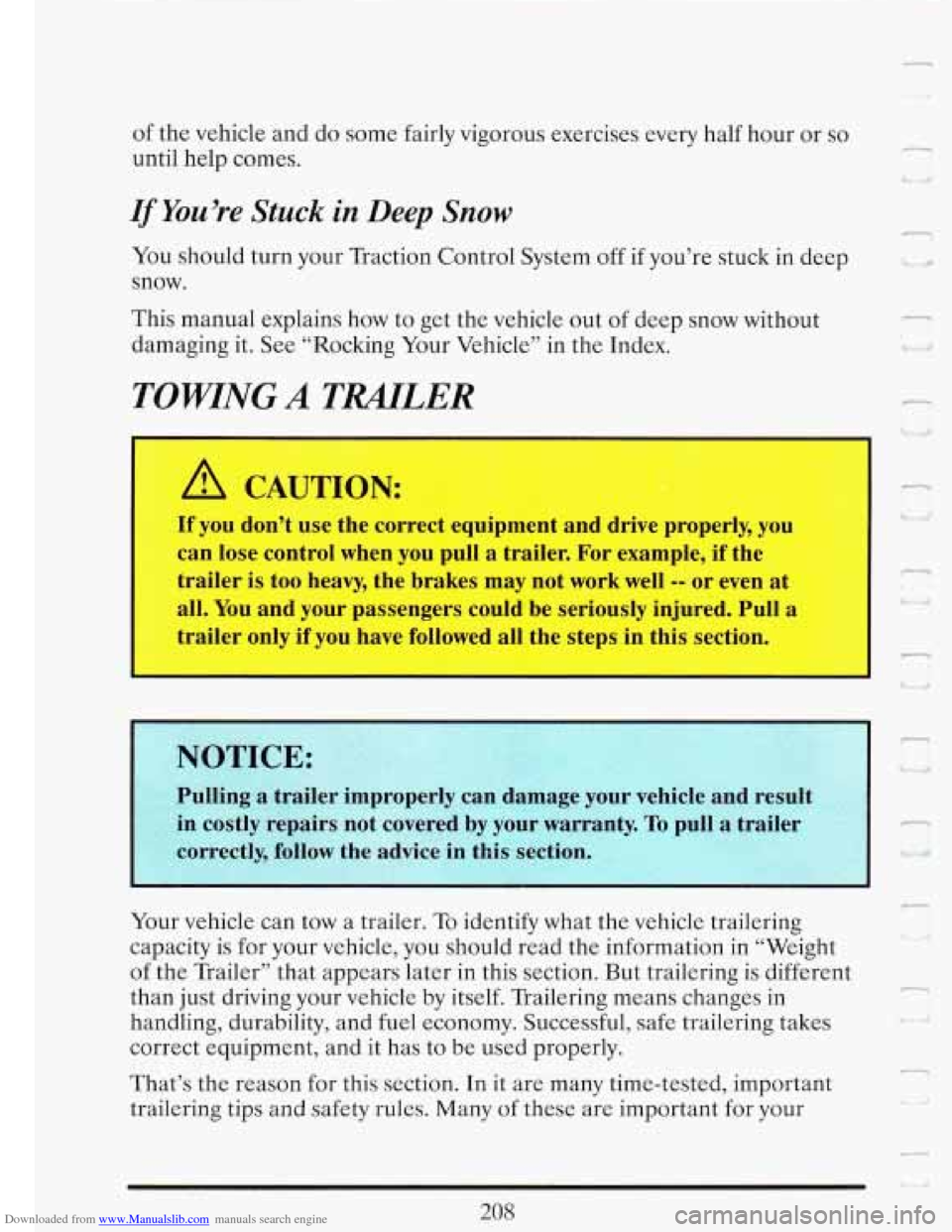
Downloaded from www.Manualslib.com manuals search engine of the vehicle and do some fairly vigorous exercises every half hour or so
until help comes.
If You’re Stuck in Deep Snow
You should turn your Traction Control System off if you’re stuck in deep
snow.
This manual explains how
to get the vehicle out of deep snow without
damaging it. See “Rocking Your Vehicle” in the Index.
TOWING A TMLER
A CAUTION:
If you don’t use the correct equipment and drive properly, you
can lose control when you pull a trailer. For example, if the
trailer is too heavy, the brakes may not work well
-- or even at
all.
You and your passengers could be seriously injured. Pull a
trailer only if you have followed all the steps in this section.
I
~~ ~ ~~ id
7
\. i
Pulling a trailer improperly can damage your vehicle and result
in costly repairs not covered by your warranty.
To pull a trailer -
c*
Your vehicle can tow a trailer. To identify what the vehicle trailering ;
capacity is for your vehicle, you should read the information in “Weight
of the Trailer” that appears later in this section. But trailering is different
than just driving your vehicle by itself. Trailering means changes in
handling, durability, and fuel economy. Successful, safe trailering takes
correct equipment, and it has to be used properly.
-
That’s the reason for this section. In it are many time-tested, important
trailering tips and safety rules. Many of these are important for your m .> d
c-
.J ~
208
Page 256 of 386
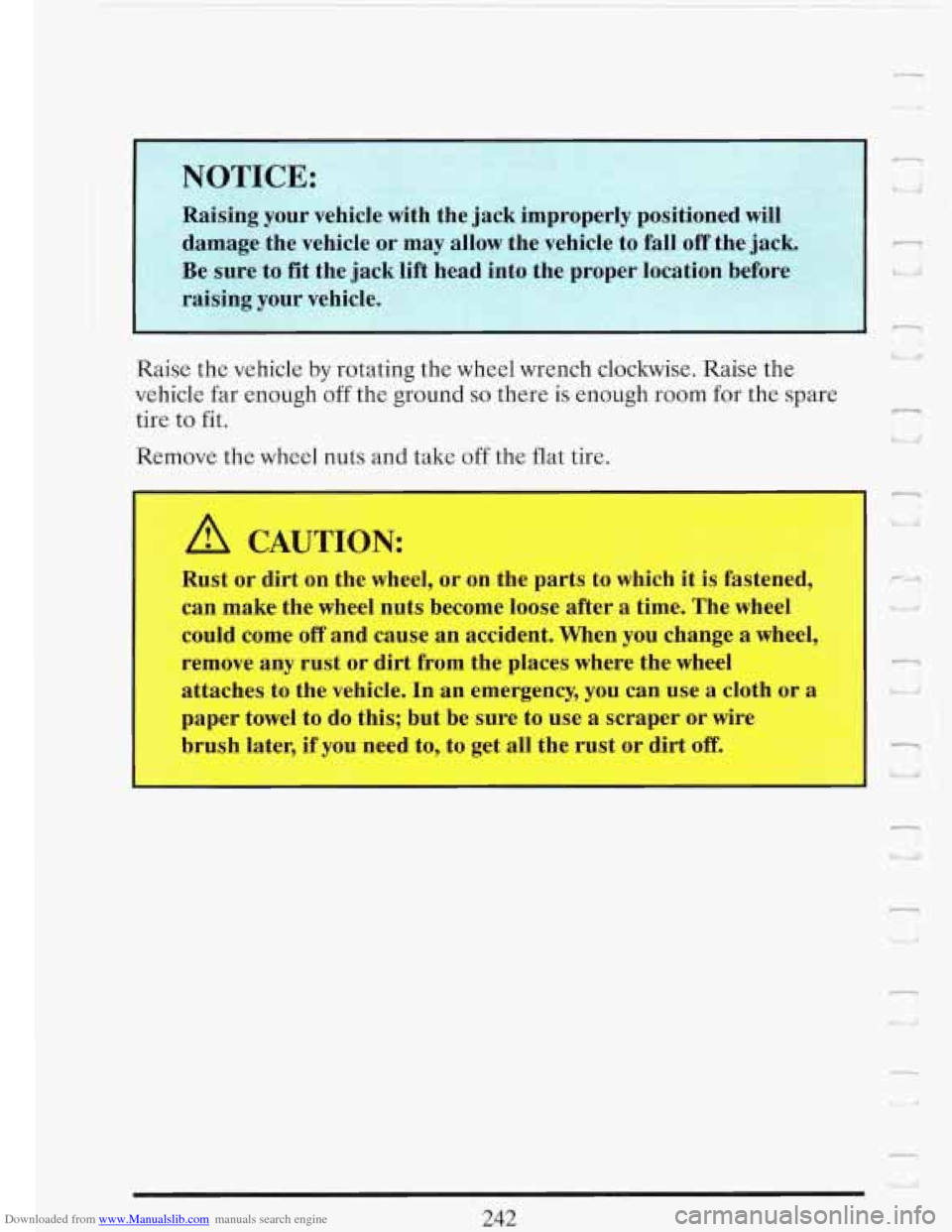
Downloaded from www.Manualslib.com manuals search engine Raise the vehicle by rotating the wheel wrench clockwise. Raise the
vehicle far enough off the ground so there is enough room for the spare
tire to fit.
Remove the wheel nuts and take off the flat tire.
- -
A CAUTION:
Rust or dirt on the wheel, or on the parts to which it is fastened,
can make the wheel nuts become loose after
a time. The wheel
could come
off and cause an accident. When you change a wheel,
remove any rust or dirt from the places where the wheel
attaches to the vehicle. In an emergency, you can use
a cloth or a
paper towel to do this; but be sure to use a scraper or wire
brush later, if you need to, to get all the rust or dirt
off.
U
I
n I " ,
-1
Page 278 of 386

Downloaded from www.Manualslib.com manuals search engine Engine Block Heater Option: An engine block heater can be a big help if
you have to park outside in
very cold weather, 0°F (-18OC) or colder. If
your vehicle has this option, see “Engine Block Heater”
in the Index.
How
To Reset the Oil Life Indicator: After the oil has been changed,
you’ll need to reset your system.
To do that, turn the ignition switch to the
“ON” position with the engine stopped fully depress and release the
accelerator pedal
3 times within 5 seconds.
If the “CHANGE OIC‘ light comes on and stays on for 5 seconds, it did
not reset. You’ll need to reset the system again.
What to
Do with Used Oil:
A CAUTION:
Used engine oil contains things that have caused skin cancer in
laboratory animals. Don’t let used oil stay on your skin for very
long. Clean your skin and nails with soap and water, or a good
hand cleaner. Wash or properly throw away clothing or rags
containing used engine oil.
Used oil can be a real threat to the environment. If you change your own
oil, be sure to drain all free-flowing oil from the filter before disposal.
-
Don’t ever dispose of oil by pouring it on the ground, into sewers, or into
streams or bodies of water. Instead, recycle it by taking
it to a place that
collects used oil. If you have a problem properly disposing of your used
oil, ask your dealer, a service station or
a local recycling center for help.
1:
n
264
I